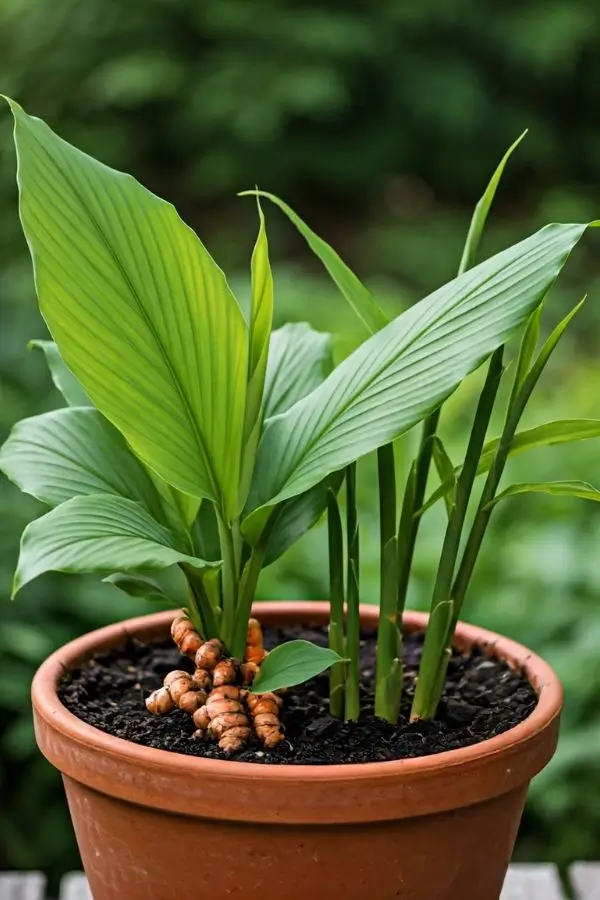Ever thought about growing ginger and turmeric right at home? You absolutely can. These tropical rhizomes are surprisingly easy to grow, especially in containers. Whether you’re limited on space or experimenting with herbal gardening, growing ginger and turmeric together is one of the best ways to start.

Why Grow Ginger and Turmeric Together?
Growing ginger and turmeric in the same pot is a smart way to maximize space and effort. Both plants thrive in similar tropical conditions, and turmeric even improves the soil, benefiting ginger’s growth. This makes them excellent companions for container gardening or small-space setups.
Their shared care needs mean you don’t have to manage two separate systems. One pot, one plan, and in a few months, you’ll be harvesting two powerful healing roots.
🌿 Related: Growing Turmeric in Pots
Interested in Tropical Healing Plants?
You may also enjoy:
Growing Moringa from Seed: Your Step-by-Step Guide to a Thriving Superfood Tree
What You’ll Need for Growing Ginger and Turmeric Successfully
These plants prefer warmth and humidity. Ideal growing temperatures are 68°F and above. Anything below 50°F can slow growth or cause stress. In colder areas, you can start them indoors and move them outside when temperatures rise.
Partial shade is often best. While both plants can tolerate full sun, they thrive with 2 to 5 hours of filtered or morning sunlight. Partial shade helps the leaves stay green and healthy throughout the season.
According to Gardeners World, ginger prefers warm, humid conditions with partial shade, making it well suited to container growing.
Don’t want to wait for sprouting? You can skip a step and start with a live ginger plant shipped directly to your door.
💡 Tip for New Shoppers: Don’t have Prime? You can get free shipping on your gardening supplies with an Amazon Prime Free Trial. Perfect for trying before you commit!
Best Soil and Containers for Growing Ginger and Turmeric
Since turmeric grows deep and ginger grows closer to the surface, they naturally share container space without overcrowding.
Use a pot that’s at least 12 inches deep and wide. Choose a soil mix that drains well and holds nutrients, ideally a blend of compost, potting mix, and coarse sand.
For best results:
- Add mulch to keep moisture in.
- Use breathable grow bags or unglazed terra cotta pots.
- Ensure your container has good drainage holes.
Recommended Potting Mix: Pre-Hydrated Coco Coir
This hydrated coco coir and chip mix creates ideal conditions for growing ginger and turmeric in pots. It holds moisture well, improves drainage, and supports healthy root growth. Use it on its own or mix with compost for better results.
Recommended Container for Growing Ginger & Turmeric
Perfect for growing ginger, turmeric, potatoes, or other deep-rooted plants. These breathable, nonwoven fabric pots help prevent root rot and allow for easy watering.
Reinforced handles for moving when full
Visible harvest window for easy access
Deep and wide enough for companion planting
Reusable, foldable, and space-saving
Use them on your patio, balcony, or garden bed for clean and efficient growing.
How to Care for Ginger and Turmeric in Pots
Moisture is key. Keep the soil consistently damp but not soggy. Too much water leads to rot. Too little causes wilting or browning.
Watch for signs:
- Yellow leaves = too much water
- Brown tips = too dry
Feed your plants monthly with a balanced organic fertilizer. Adding a slow-release compost or worm castings helps maintain steady nutrition.
Harvesting Tips
Both plants need 8 to 10 months to mature. You’ll know they’re ready when the leaves begin to yellow and dry out.
- Harvest turmeric first since it grows deeper.
- Ginger can often be left a bit longer for a larger yield.
Use a garden fork or your hands to gently dig around the roots. Store them in a cool, dry place or refrigerate short-term.
Common Growing Issues and How to Fix Them
The biggest issue is root rot, caused by overwatering or poor drainage. Always check soil moisture before watering. You can use a simple finger test or a moisture meter.
Other tips:
- Use fresh, disease-free planting rhizomes.
- Make sure pots have drainage holes.
- Don’t crowd the roots too tightly.
Final Tips for Success
- Start with fresh, organic ginger and turmeric rhizomes
- Plant in spring when soil is warming
- Use a breathable pot like terra cotta or grow bags
- Mulch the top of the soil to conserve moisture
- Be patient, especially in cooler climates
Add This to Your Home Garden or Balcony
Growing ginger and turmeric together is a satisfying and practical way to produce your own spices. Whether you’re mixing up golden milk, steeping morning tea, or spicing a curry, you’ll always have fresh ingredients at your fingertips.


